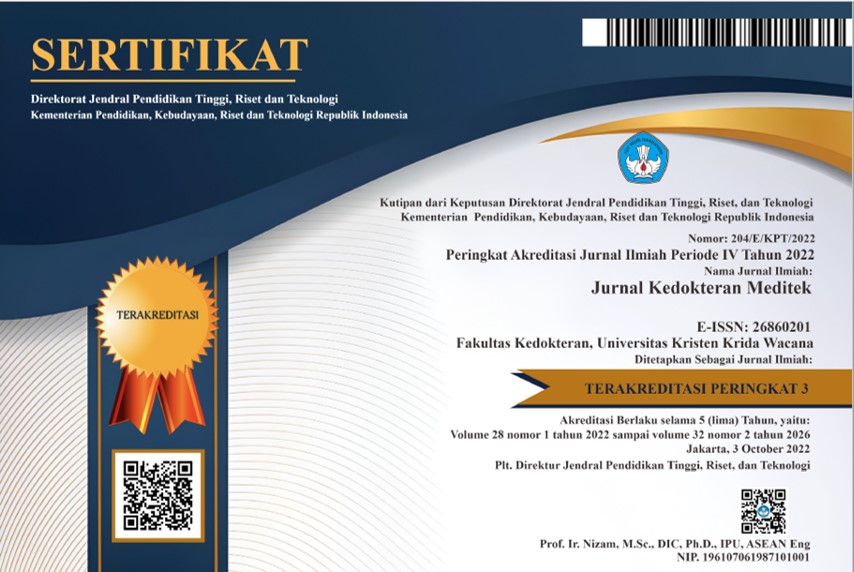A Rare Case: HaemoglobinS-Thalassemia in Adult
DOI:
https://doi.org/10.36452/jkdoktmeditek.v29i2.2540Keywords:
HaemoglobinS, hemoglobinopathy, Haemoglobin sickle-cell anemia, thalassemiaAbstract
Hemoglobinopathy refers to a disease involving a qualitative or quantitative defect of the structure or synthesis of haemoglobin molecules. The HaemoglobinS- beta thalassemia occurs in a heterozygotes individual with beta-thalassemia and HaemoglobinS gene. A 29-year-old man came with severe anemia, thrombocytopenia, and history of repeated blood transfusions. Physical examination showed pale conjunctiva, pansystolic murmurs, and hepatosplenomegaly. The HaemoglobinS fraction was found in haemoglobin electrophoresis with increased HaemoglobinF and decreased HaemoglobinA2 fraction. The peripheral blood smear shows abnormal erythrocytes morphologies such as pencil shapes, fragmentocytes, target cells, and sickle shapes. The patient was diagnosed with chronic anaemia caused by HaemoglobinS-beta thalassemia. It makes ineffective erythropoiesis, intravascular, and extravascular hemolysis. This haemoglobinopathy caused increased ferritin and transferrin saturation. The presence of renal failure indicate there is a complicated condition like microvascular obstruction of renal. In this case, there is a reduction of HaemoglobinA2 fraction that is not common in HaemoglobinS-beta thalassemia. The patient with Haemoglobin S / beta+ thalassemia shows intravascular hemolysis, ineffective hematopoiesis, and vaso-occlusive signs. Deoxyribo Nucleic Acid analysis is further needed to confirm the combination defect of haemoglobin synthesis disorders in conjunction with alpha thalassemia or Hereditary persistence of fetal haemoglobin.
References
Laudicina RJ. Hemoglobinopathies: qualitative defects. In: McKenzie SB, Williams JL, editors. Clinical laboratory haematology. 3rd ed. United Kingdom: Pearson Education; 2016 p. 263-79.
Marsh A, Vichinsky EP. Sickle cell disease.In: Hoffbrand AV, Higgs DR, Keeling DM, Mehta AB, editors. Postgraduate haematology. 7th ed. United Kingdom: John Wiley & Sons Ltd; 2016. p. 98—113
Keohane EM. Thalassemias. In: Keohane E, Smith L, Walenga J, editors. Rodak’s haematology clinical principles and applications. 5th ed. Missouri: Elsevier Saunders; 2016. p. 454–74.
Kato GJ, Steinberg MH, Gladwin MT. Intravascular hemolysis and the pathophysiology of sickle cell disease. JCI. 2017;127(3):750-60.
Randolph TR. Hemoglobinopathies. In: Keohane E, Smith L, Walenga J, editors. Rodak’s hematology clinical principles and applications. 5th ed. Missouri: Elsevier Saunders; 2016. p. 429-41.
Piel FB, Steiberg MH, Rees DC. Sickle cell disease. NJEM. 2017;376(16):1561- 73.
Connes P, Lamarre Y, Waltz X, Ballas SK, Lemonne N, Julan ME, et al. Haemolysis and abnormal haemorheology in sickle cell anaemia. Br J Haematol. 2014;165(4):564-72.
Figueiredo MS. The compound state: Haemoglobin S/beta-thalassemia. Rev Bras Hematol Hemoter. 2015;37(3):150–2.
Paikari A, Sheehan VA. Fetal haemoglobin induction in sickle cell disease. Br J Haematol. 2018;180(2):189-200.
Gardner RV. Sickle cell disease: advances in treatment. Ochsner Journal. 2018;18:377–89.
Wild BJ, Bain BJ. Investigation of abnormal haemoglobins and thalassaemia. In: Bain BJ, Bates I, Laffan MA, Lewis SM, editors. Dacie and Lewis practical hematology. Churcill Livingstone: Elsevier; 2011. p. 301-21.
Zur B, Ludwg M, Wagner BS. Hemoglobin hasharon and hemoglobin NYU in subjects of german origin. Biochemia Medica. 2011;21(3):321-5.
Jajor ED, Skulimoska J, Ejduk A, Guz K, Uhrynowska M, Brojer E. Coexistence of hemoglobin handsworth and alpha 3.7 kb deletion in caucasian woman in poland. Acta Haematologica Polonia. 2019; 50(1):21-4.
Gkamprela E, Deutsch M, Pectasides D. Iron deficiency anemia in chronic liver disease: ethiopathogenesis, diagnosis, and treatment. Ann Gatroenterol. 2017; 30(4):405-13.
Canalli AA, Conran N, Fattori A, Saad STO, Costa FF. Increased adhesive properties of eosinophils in sickle cell disease. Experimental Hematology. 2004:32;728–34.
Lehrer-Graiwer J, Howard J, Hemmaway CJ. GBT440, a potent anti-sickling hemoglobin modifier reduces hemolysis, improves anemia and nearly eliminates sickle cells in peripheral blood of patients with sickle cell disease. Blood. 2015;126(23):542.
Achebe M. Sickle cell syndrome. In: Edward J. Benz, Jr., Nancy Berliner, Fred J. Schiffman, editors. Anemia: pathophysiology, diagnosis and management. United Kingdom: Cambridge University Press; 2018. p. 39-165.
Conran N, Belcher JD. Inflammation in sickle cell disease. Clin Hemorheol Microcirc. 2018;68(2-3):263-299.
Keikhaei B, Mohseni AR, Norouzirad R, Alinejadi M, Ghanbari S, Shiravi Fet al. Altered levels of proinflammatory cytokines in sickle cell disease patients during vaso-occlusive crises and the steady state condition. Eur Cytokine Netw. 2013 Mar;24(1):45-52.
NKF-KDIGO. KDIGO Clinical practice guidline for acute kidney injury. 2012. [cited 2020 Jan 20]. Available on: https://kdigo.org/.
Downloads
Published
How to Cite
Issue
Section
License
Copyright (c) 2023 Linny Luciana, Ninik Sukartini

This work is licensed under a Creative Commons Attribution-NonCommercial-ShareAlike 4.0 International License.

















